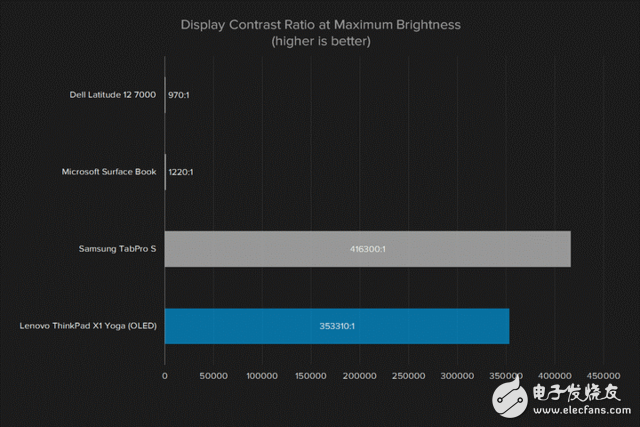According to the Digital Trends website, notebook display technology has not changed in the past few decades. Except for a few early models in the 1980s, they generally used LED displays.
This has been the advantage of notebooks for many years, but recently LED displays have dragged the back of the notebook. Why do you say that? The LED display requires a backlight, which cannot be completely turned off (if it can be completely turned off, the user will not see the content on the display at all). Even if the display shows dark black, the LED display will still glow.
TV fans are very dissatisfied with this, which is why plasma TVs are liked by home theater enthusiasts. At present, the "crown" of plasma TV has been replaced by OLED TV, and notebooks will also use OLED display.
The naked eye can find the difference between the two

Readers are likely to have never seen an OLED TV or notebook before (OLED is very common on mobile phones). Readers may want to know the difference between OLED and LED screens. The following figure illustrates this well:
The picture above is a comparison of the contrast between two OLED displays and the best two LED display notebooks. The difference is still quite large. When the OLED display shows a pure black image, Digital Trends used to test the notebook's sensor - Datacolor's Spyder5Elite, the detected screen brightness is zero. Therefore, the value of the contrast depends on the highest brightness of the display.
Don't be too excited. Although the raw data shows that the contrast of the OLED screen is much higher than the traditional LED screen. In fact, the advantage of contrast is limited because there is a limit to the contrast between the human eye and the viewing content.
Digital Trends said that users can notice the black level of the display. The gray that was seen in movies and television in the past was replaced by pure black. Users will even notice this in more mundane tasks, and the display of web pages will suddenly become finer and more colorful, comparable to printed magazines.
Battery life is an inadequacy

There is no doubt that OLEDs can dramatically improve image quality. The two systems tested by Digital Trends - Lenovo ThinkPad X1 Yoga and Samsung TabPro S - are equipped with the best PC display. In addition to the extremely high contrast ratio, the OLED panel has a wider color gamut and a better gamma curve. Color accuracy is not the best we have ever seen, but it is not bad.
The Lenovo ThinkPad X1 Yoga proved to be the perfect OLED technology test bed, as Digital Trends has tested models with OLED and non-OLED displays. The standard IPS LED screen resolution even reaches the level of the OLED screen, so the two are highly comparable.
The test results are clear and consistent. Depending on the load, using an OLED screen will reduce battery life by 10%-25%. When running the Peacekeeper Internet surfing test program, the battery life has the greatest impact. The background is white during the test, so the screen brightness is very high. The battery life in the video test is minimally affected. This is understandable because there are many videos. Low brightness scene.
Why is the battery life shorter? According to the current state of the art, a fully illuminated OLED display consumes more energy than an LED display. The OLED display does not require a backlight and each pixel will illuminate. When all pixels are illuminated, the OLED display consumes a lot more energy.
According to Digital Trends, battery life is not an advantage of OLED displays, but it is not catastrophic. If you switch to an OLED display, your laptop battery life may be reduced from 5 hours to 4 hours. This is certainly not good news for users who need 5 hours of battery life, but it doesn't matter for users who use it for a little more than 3 hours.
Will you buy an OLED notebook?
The Samsung TabPro S comes standard with an OLED display. However, it will increase the cost of notebooks. In X1 Yoga, the cost of OLED display is 125 US dollars (about 836 yuan), and the high-end version of HP Spectre x360 with OLED display is priced at 1,500 US dollars (about 10028 yuan). The price of the OLED version of the Alien 13 is 1,300 US dollars (about RMB 8,691).
Ordinary users who want to buy a notebook with a price of about 600 US dollars (about RMB 4011) should not expect the OLED screen. OLED displays are expensive and may not be used in mainstream notebooks in the next few years.
If you consider buying a high-end notebook, Digital Trends believes that the OLED screen is worth considering - although it is expensive. As long as you use a notebook, users can't leave the screen. The screen is irreplaceable and it won't be out of date very quickly.
In fact, if you can choose between upgrading the OLED screen and the processor, it is best to upgrade the OLED screen. Of course, the premise is that you don't care about sacrificing some battery life.
NY280 Engine 6 Series:power Range 1650KWm-5000KWm
Engine.1650KWm-5000KWm
CCSN POWER GENERATION INC.(Engine is a subsidiary of CCSN) , https://www.ccsnengine.com